Spring has sprung in Canada and with it comes barbecue season. Therefore, it is fitting that US President Donald Trump picked this time of year to turn up the heat on the Canadian dollar. In fact, he didn’t just turn up the heat, he fired up the grill, put the Loonie on a skewer and started to roast it.
President Trump’s recipe for roast Loonie is rather simple. You season with a dash of Dairy, then sear over Softwood lumber coals. As soon as it starts to brown, turn the burner to high using NAFTA gas. You know it is done, when American special interest groups praise the “Fair Trade-Not Free Trade” champion and the Loonie is charred.
On April 26, there was a rumour that President Trump was going to announce that he was pulling the United States out of the North American Free Trade Agreement. (NAFTA).
That caused a kerfuffle in Ottawa and Mexico City. The Canadian dollar and Mexican Peso were sold aggressively. That night, the rumour proved false. The White House said Trump reached out to Mexican President Enrique Nieto and Canada’s Prime Minister Trudeau in what was described as a pleasant and productive phone call. Apparently, he is not planning to terminate NAFTA but merely to “bring NAFTA up-to-date through renegotiation.”
Was the rumour a calculated ploy by the US administration to ensure that the renegotiation playing field is tilted even further in America’s favour?
The population of the US is over nine times that of Canada and more than double that of Mexico. The size of the US market means that the US already has the upper hand in any free trade negotiations.
Arguably, the US decision to impose 20% countervailing duties on Canadian softwood lumber imports was a message from Trump to Trudeau, that unless Canada caves in to US demands, these are the type of measures that can be expected in the coming months. Obviously, the President believes in walking boldly while carrying a big, softwood stick.
The Loonie is under stress from other Trump policies. On Wednesday, Treasury Secretary Steven Mnuchin and National Economic Director Gary Cohn outlined President Trump’s tax plan. They even sounded like their boss.
There was no shortage of praiseworthy adjectives to describe their plans; “it is quite an historic day, one that we have been looking forward to for a long time”, “we are very excited”, “a once in a generation opportunity”, the most significant tax reform legislation since 1986” and of course it is the “biggest tax cut in history”
Highlights of the plan include cutting the seven individual tax brackets to three, while reducing corporate tax rates from 35 percent to 15 percent.
As with many of President Trump’s initiatives, there was a lack of detail. FX markets reacted by unwinding some long US dollar positions.
The tax plan did include the provision for a one-time ten percent tax on foreign earnings. Fox news reported that Apple is sitting on US $230 billion and Microsoft has $123 billion in foreign accounts. They are only two of the thousands of American multinationals holding cash offshore.
If the Trump administration can make it attractive for these companies to repatriate their funds, it could mean substantial demand for US dollars. Broad US dollar strength would undermine the Canadian dollar.
Trump also kicked sand into the face of the Canadian oil industry. A week ago, when the president was taking verbal shots at Canadian softwood lumber and dairy producers he referenced “energy”. He never said anything more.
That reference comes at a time when US oil production is rising. Wednesday’s Presidential Executive Order on the Review of Designations Under the Antiquities Act has some critics concerned that he may open up protected Federal lands to drilling, mining and logging. Rising US oil production would mean less demand for Canadian oil.
Oil prices are already causing headaches for the Loonie. In the past two weeks, West Texas Intermediate (WTI) oil has declined from $53.72/barrel to $48.50 on April 27.
Oil traders are concerned about stubbornly high crude inventories which could get worse if the Opec production cut agreement is not extended beyond June 30.
A Bloomberg article on April 26 suggested that Saudi Arabia was losing market share to Iran and Iraq. That news may not go over to well in Riyadh. The world is still recovering from the last time that Saudi Arabia, vexed with losing market share, turned on the taps.
Potentially massive US dollar repatriation flows, NAFTA renegotiation and falling oil prices have hung a target on the 0.70 cent level for the Canadian dollar. In the current environment, forecasters will likely score a bullseye.







